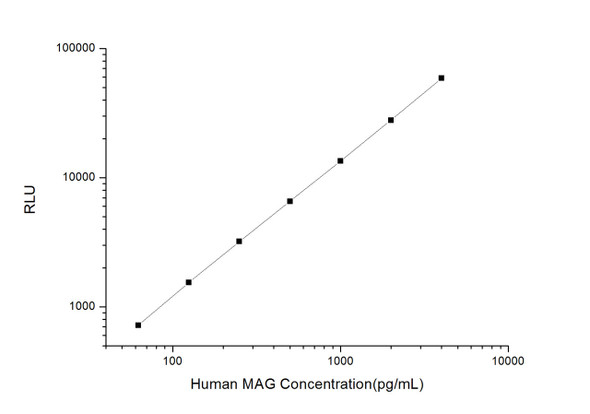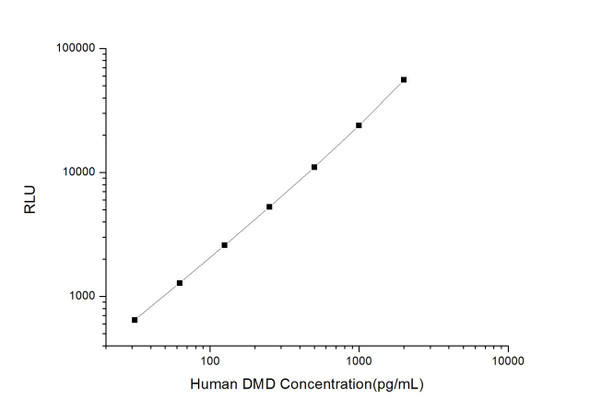Human Immunology ELISA Kits 1
Human DAG1 (Dystrophin Associated Glycoprotein 1) CLIA Kit (HUES01283)
- SKU:
- HUES01283
- Product Type:
- ELISA Kit
- ELISA Type:
- CLIA Kit
- Size:
- 96 Assays
- Sensitivity:
- 37.5pg/mL
- Range:
- 62.5-4000pg/mL
- ELISA Type:
- Sandwich
- Reactivity:
- Human
- Sample Type:
- Serum, plasma and other biological fluids
- Research Area:
- Immunology
Description
| Assay type: | Sandwich |
| Format: | 96T |
| Assay time: | 4.5h |
| Reactivity: | Human |
| Detection method: | Chemiluminescence |
| Detection range: | 62.50-4000 pg/mL |
| Sensitivity: | 37.50 pg/mL |
| Sample volume: | 100µL |
| Sample type: | Serum, plasma and other biological fluids |
| Repeatability: | CV < 15% |
| Specificity: | This kit recognizes Human DAG1 in samples. No significant cross-reactivity or interference between Human DAG1 and analogues was observed. |
This kit uses Sandwich-CLIA as the method. The micro CLIA plate provided in this kit has been pre-coated with an antibody specific to Human DAG1. Standards or samples are added to the appropriate micro CLIA plate wells and combined with the specific antibody. Then a biotinylated detection antibody specific for Human DAG1 and Avidin-Horseradish Peroxidase (HRP) conjugate are added to each micro plate well successively and incubated. Free components are washed away. The substrate solution is added to each well. Only those wells that contain Human DAG1, biotinylated detection antibody and Avidin-HRP conjugate will appear fluorescence. The Relative light unit (RLU) value is measured spectrophotometrically by the Chemiluminescence immunoassay analyzer. The RLU value is positively associated with the concentration of Human DAG1. The concentration of Human DAG1 in the samples can be calculated by comparing the RLU of the samples to the standard curve.
| UniProt Protein Function: | DAG1: a cytoskeletal protein that functions as a laminin receptor. Provides a linkage between the subsarcolemmal cytoskeleton and the extracellular matrix. May be involved in autosomal recessive muscular dystrophies. Its dramatic reduction in Duchenne muscular dystrophy leads to a loss of linkage between the sarcolemma and extracellular matrix, rendering muscle fibers more susceptible to necrosis. Dystroglycan also functions as dual receptor for agrin and laminin-2 in the Schwann cell membrane. Binds to several types of arenaviruses. Is a target for the entry of Mycobacterium leprae into peripheral nerve Schwann cells. The muscle and nonmuscle isoforms of dystroglycan differ by carbohydrate moieties but not protein sequence. |
| UniProt Protein Details: | Protein type:Cytoskeletal; Motility/polarity/chemotaxis; Membrane protein, integral Chromosomal Location of Human Ortholog: 3p21 Cellular Component: dystroglycan complex; extracellular space; costamere; focal adhesion; basolateral plasma membrane; integral to membrane; extracellular region; lipid raft; nucleoplasm; dystrophin-associated glycoprotein complex; postsynaptic membrane; cytoskeleton; cell-cell adherens junction; lamellipodium; cytoplasm; plasma membrane; basement membrane; sarcolemma; filopodium Molecular Function:tubulin binding; viral receptor activity; laminin-1 binding; protein binding; structural constituent of muscle; protein complex binding; SH2 domain binding; calcium ion binding; alpha-actinin binding; actin binding; vinculin binding Biological Process: nerve maturation; response to peptide hormone stimulus; entry of virus into host cell; extracellular matrix organization and biogenesis; negative regulation of protein kinase B signaling cascade; cytoskeletal anchoring; negative regulation of MAPKKK cascade; membrane protein ectodomain proteolysis; NLS-bearing substrate import into nucleus; myelination in the peripheral nervous system; virus-host interaction; morphogenesis of an epithelial sheet; calcium-dependent cell-matrix adhesion; negative regulation of cell migration Disease: Muscular Dystrophy-dystroglycanopathy (limb-girdle), Type C, 9; Muscular Dystrophy-dystroglycanopathy (congenital With Brain And Eye Anomalies), Type A, 9 |
| NCBI Summary: | Dystroglycan is a laminin binding component of the dystrophin-glycoprotein complex which provides a linkage between the subsarcolemmal cytoskeleton and the extracellular matrix. Dystroglycan 1 is a candidate gene for the site of the mutation in autosomal recessive muscular dystrophies. The dramatic reduction of dystroglycan 1 in Duchenne muscular dystrophy leads to a loss of linkage between the sarcolemma and extracellular matrix, rendering muscle fibers more susceptible to necrosis. Dystroglycan also functions as dual receptor for agrin and laminin-2 in the Schwann cell membrane. The muscle and nonmuscle isoforms of dystroglycan differ by carbohydrate moieties but not protein sequence. Alternative splicing results in multiple transcript variants all encoding the same protein. [provided by RefSeq, Apr 2010] |
| UniProt Code: | Q14118 |
| NCBI GenInfo Identifier: | 229462879 |
| NCBI Gene ID: | 1605 |
| NCBI Accession: | Q14118. 2 |
| UniProt Secondary Accession: | Q14118,Q969J9, A8K6M7, |
| UniProt Related Accession: | Q14118 |
| Molecular Weight: | 97,441 Da |
| NCBI Full Name: | Dystroglycan |
| NCBI Synonym Full Names: | dystroglycan 1 (dystrophin-associated glycoprotein 1) |
| NCBI Official Symbol: | DAG1 |
| NCBI Official Synonym Symbols: | A3a; DAG; AGRNR; 156DAG; MDDGC7; MDDGC9 |
| NCBI Protein Information: | dystroglycan |
| UniProt Protein Name: | Dystroglycan |
| UniProt Synonym Protein Names: | Dystrophin-associated glycoprotein 1 |
| Protein Family: | Dystroglycan |
| UniProt Gene Name: | DAG1 |
| UniProt Entry Name: | DAG1_HUMAN |
As the RLU values of the standard curve may vary according to the conditions of the actual assay performance (e. g. operator, pipetting technique, washing technique or temperature effects), the operator should establish a standard curve for each test. Typical standard curve and data is provided below for reference only.
| Concentration (pg/mL) | RLU | Average | Corrected |
| 4000 | 57179 60983 | 59081 | 59046 |
| 2000 | 27208 28510 | 27859 | 27824 |
| 1000 | 14111 12857 | 13484 | 13449 |
| 500 | 6108 7102 | 6605 | 6570 |
| 250 | 3389 3097 | 3243 | 3208 |
| 125 | 1646 1516 | 1581 | 1546 |
| 62.50 | 721 789 | 755 | 720 |
| 0 | 34 36 | 35 | -- |
Precision
Intra-assay Precision (Precision within an assay): 3 samples with low, mid range and high level Human DAG1 were tested 20 times on one plate, respectively.
Inter-assay Precision (Precision between assays): 3 samples with low, mid range and high level Human DAG1 were tested on 3 different plates, 20 replicates in each plate.
| Intra-assay Precision | Inter-assay Precision | |||||
| Sample | 1 | 2 | 3 | 1 | 2 | 3 |
| n | 20 | 20 | 20 | 20 | 20 | 20 |
| Mean (pg/mL) | 183.70 | 640.59 | 1981.45 | 185.71 | 579.16 | 1843.92 |
| Standard deviation | 15.16 | 65.79 | 173.18 | 23.12 | 62.03 | 120.96 |
| C V (%) | 8.25 | 10.27 | 8.74 | 12.45 | 10.71 | 6.56 |
Recovery
The recovery of Human DAG1 spiked at three different levels in samples throughout the range of the assay was evaluated in various matrices.
| Sample Type | Range (%) | Average Recovery (%) |
| Serum (n=5) | 93-105 | 98 |
| EDTA plasma (n=5) | 99-112 | 105 |
| Cell culture media (n=5) | 89-100 | 94 |
Linearity
Samples were spiked with high concentrations of Human DAG1 and diluted with Reference Standard & Sample Diluent to produce samples with values within the range of the assay.
| Serum (n=5) | EDTA plasma (n=5) | Cell culture media (n=5) | ||
| 1:2 | Range (%) | 87-100 | 99-115 | 101-115 |
| Average (%) | 93 | 105 | 109 | |
| 1:4 | Range (%) | 87-99 | 95-110 | 84-97 |
| Average (%) | 94 | 100 | 90 | |
| 1:8 | Range (%) | 86-99 | 87-102 | 92-104 |
| Average (%) | 93 | 94 | 99 | |
| 1:16 | Range (%) | 95-110 | 95-112 | 91-107 |
| Average (%) | 101 | 102 | 98 |
An unopened kit can be stored at 4°C for 1 month. If the kit is not used within 1 month, store the items separately according to the following conditions once the kit is received.
| Item | Specifications | Storage |
| Micro CLIA Plate(Dismountable) | 8 wells ×12 strips | -20°C, 6 months |
| Reference Standard | 2 vials | |
| Concentrated Biotinylated Detection Ab (100×) | 1 vial, 120 µL | |
| Concentrated HRP Conjugate (100×) | 1 vial, 120 µL | -20°C(shading light), 6 months |
| Reference Standard & Sample Diluent | 1 vial, 20 mL | 4°C, 6 months |
| Biotinylated Detection Ab Diluent | 1 vial, 14 mL | |
| HRP Conjugate Diluent | 1 vial, 14 mL | |
| Concentrated Wash Buffer (25×) | 1 vial, 30 mL | |
| Substrate Reagent A | 1 vial, 5 mL | 4°C (shading light) |
| Substrate Reagent B | 1 vial, 5 mL | 4°C (shading light) |
| Plate Sealer | 5 pieces | |
| Product Description | 1 copy | |
| Certificate of Analysis | 1 copy |
- Set standard, test sample and control (zero) wells on the pre-coated plate and record theirpositions. It is recommended to measure each standard and sample in duplicate. Note: addall solutions to the bottom of the plate wells while avoiding contact with the well walls. Ensuresolutions do not foam when adding to the wells.
- Aliquot 100 µL of standard solutions into the standard wells.
- Add 100 µL of Sample / Standard dilution buffer into the control (zero) well.
- Add 100 µL of properly diluted sample (serum, plasma, tissue homogenates and otherbiological fluids. ) into test sample wells.
- Cover the plate with the sealer provided in the kit and incubate for 90 min at 37 °C.
- Aspirate the liquid from each well, do not wash. Immediately add 100 µL of BiotinylatedDetection Ab working solution to each well. Cover the plate with a plate seal and gently mix. Incubate for 1 hour at 37 °C.
- Aspirate or decant the solution from the plate and add 350 µL of wash buffer to each welland incubate for 1-2 minutes at room temperature. Aspirate the solution from each well andclap the plate on absorbent filter paper to dry. Repeat this process 3 times. Note: a microplatewasher can be used in this step and other wash steps.
- Add 100 µL of HRP Conjugate working solution to each well. Cover with a plate seal andincubate for 30 min at 37 °C.
- Aspirate or decant the solution from each well. Repeat the wash process for five times asconducted in step 7.
- Add 100 µL of Substrate mixture solution to each well. Cover with a new plate seal andincubate for no more than 5 min at 37 °C. Protect the plate from light.
- Determine the RLU value of each well immediately.






